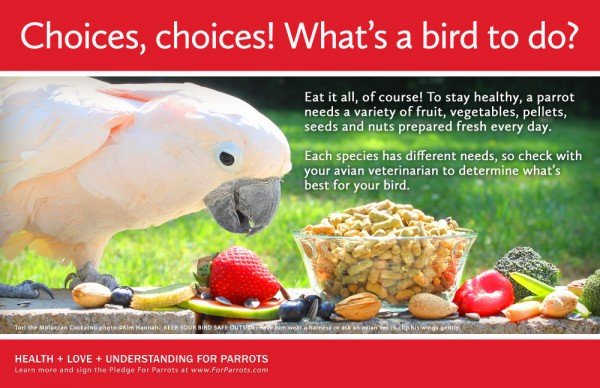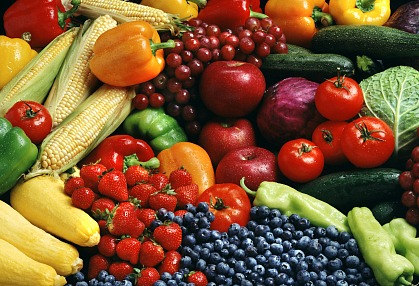I’m very excited to present a new line of posters, designed specifically for people who have companion parrots, or have done the research and made the decision to adopt a bird and want more information. These posters can also be used by rescues who want to make sure that people sharing their lives with birds have the proper information to ensure the bird has a good, healthy, happy existence with their caretakers.
I have been fortunate to be able to work with Kim Hannah for these posters. Kim has a flock of model-ready parrots, and is very adept with her camera, as you will see. In these posters, you will meet Tori and Andy (Moluccan Cockatoos), Mambo (a Congo African Grey), Nyah (a Red Lored Amazon), and Lilly and Annabelle (Umbrella Cockatoos).
Our first series of posters have to do with FOOD! Yum! It wasn’t so long ago that people who had birds thought that a bag of bird seed was all that was needed to feed a bird. Not so! Now we know that parrots need a variety of fruit, vegetables, seeds, nuts and pellets to stay healthy. These need to be prepared fresh each day, although there are ways to save time doing this.
Patricia Sund has been promoting “Chop” for a while now. Chop is exactly what it sounds like: a mish-mash of healthy food which is chopped up and then divided up into separate zip-lock bags and frozen. A bag can be thawed and warmed up each day, and provides your bird with many of the nutrients it needs. Check out her site to see how easy it is.
Phoenix Landing has a great page on what foods are important for your bird, and why. For example:
Calcium is a key element for all parrots. Calcium-rich foods include leafy greens, carrots, unhulled sesame seeds, broccoli, dandelion and other greens, yogurt and almonds. To absorb calcium, vitamin D3 is needed, which can be acquired through sunlight naturally, or in pellets as a supplement. Let your parrot enjoy some safe time outdoors or provide access to a full spectrum light. Light filtered through window panes is not full spectrum.
Pay attention to what your bird actually eats, not just what you provide. If your parrot has not learned to eat fresh foods, try mixing minced food into pellets or seed, make a warm mash with a favorite item sprinkled on top to create curiosity, or play a game and show your parrot that it is yummy to eat a particular food. Don’t give up, your bird can learn to enjoy healthy foods in addition to pellets!
Dr. Scott Echols, an avian veterinarian, has provided a number of different informational forms on his site. One is about safe plants for birds, one for toxic plants, and one for foods for different avian species. This last form also has some great hints for converting a seed-eating bird to a much healthier fruit/veggie/pellet diet. In addition, he notes some foods NOT recommended for birds:
Flour based foods (bread, tortillas, cookies, crackers, etc), dried fruits, fruit juice, foods sweetened with natural or artificial sweeteners, grapes, bananas, citrus fruits, fried foods and fatty animal meat. No raw beans. (Cooked beans are acceptable for some large parrots.) Grit is not needed for caged pet birds however can be beneficial for ground feeding birds eating tough fibrous foods (usually not a concern with pets).
Sprouts are a great way to get the very freshest food available for your bird. You can easily grow them yourself (they are good for you, too!). In addition, sprouts can also provide a fun bathing spot for the smaller birds! Just take a look at this video to see what I mean:
Sprouts for parrots (from The Gabriel Foundation):
Sprout Mix contains a variety of seeds, grains, and legumes. Sprouts are as close to ‘natural’ as you can get and once growth is initiated there is a remarkable transformation in the seeds, grains, and legumes as nutrients are made available to support the growth of a tiny plant. Sprouts are a source of carbohydrates and protein and are a much better alternative, especially for the companion eclectus, to cooked grain/rice/bean mixes of various kinds (which are very high in carbohydrates and calories) and birdie breads.
There are many resources online to help you with proper avian nutrition, and I have added some links at the bottom of this generalized post to help you on your way. Keep an eye out over the next little while as the Hannah Flock teaches us more about Parrot Nutrition with more great posters.
Further links about parrots’ dietary needs and food prep ideas:
- Patricia Sund’s Chop
- Patricia Sund’s Chop Recipe on Phoenix Landing’s site
- Nutrition for Pets Facebook Group, with Dr. Scott Echols
- Nutrition notes on Phoenix Landing’s site
- Carolyn’s Recipes (Eclectus focused site but relevant to most other parrots too.)
- Parrot Foraging and Fun
- Cooking for Parrots
- Edible Flowers for Parrots
- Flowers For Parrots, from Peggy’s Parrot Place
- The Kitchen Physician, including herbal remedies and holistic treatments for parrots.
- The Healthy Bird Cookbook, by Robin Deutsch
- Polly Wants More Than A Cracker, a parrot owner’s cookbook by Parrot Toy Angels
- Sprouting for Nutrition – The Gabriel Foundation (.doc)
- Best technique for sprouting – The Gabriel Foundation (.doc)
- When a seed sprouts – The Gabriel Foundation (.pdf)
Note that this poster can be printed LARGE (11″ x 17″), though you can still print it on an 8.5″ x 11″ page.









No comments yet.